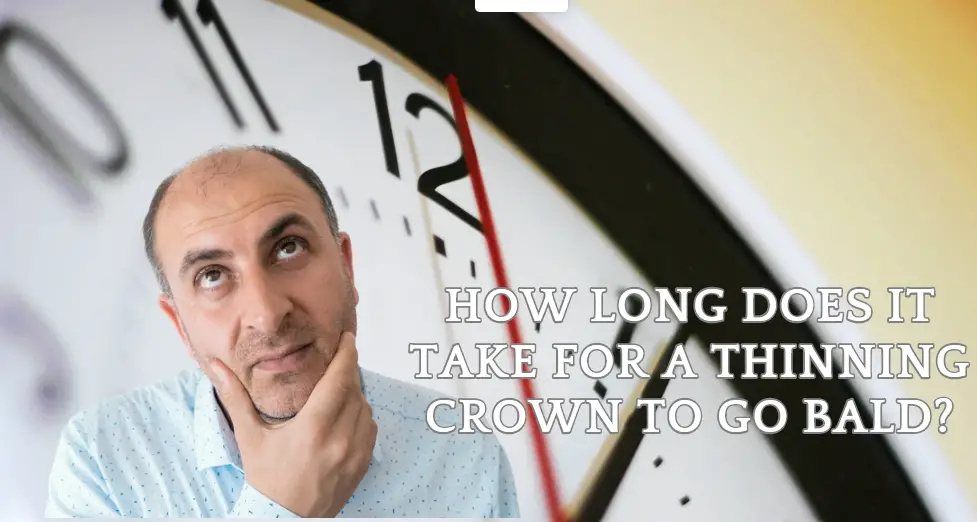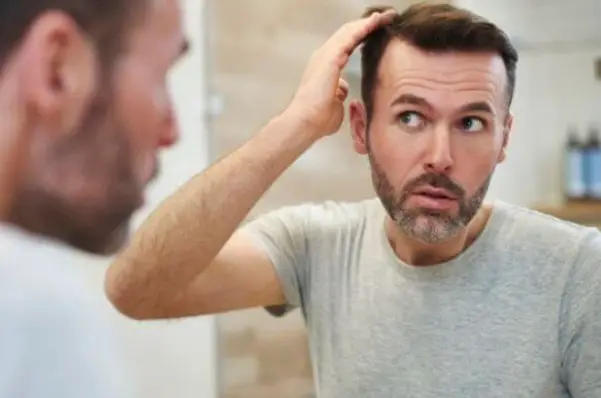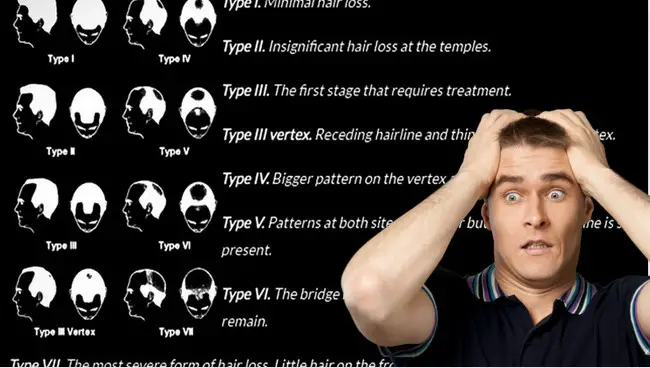Discover the timeline of how long does it take for a thinning crown to go bald in men. Understand the stages and factors that influence male pattern baldness.
Hair loss is a common problem that affects both men and women. One of the most noticeable signs of hair loss is thinning at the crown. Many people wonder how long it takes for a thinning crown to go bald. The answer to this question depends on a variety of factors, including genetics, age, and lifestyle.
Understanding Hair Loss Hair loss is a natural part of the aging process. As people age, their hair follicles shrink, and hair growth slows down. This can lead to thinning hair, bald spots, and receding hairlines. Hair loss can also be caused by a variety of other factors, including hormonal changes, stress, and certain medical conditions.
How Long Does It Take for a Thinning Crown to Go Bald?
Timeline of Hair Loss The timeline of hair loss can vary greatly from person to person. Some people may notice thinning hair in their 20s, while others may not experience significant hair loss until their 50s or 60s. In general, hair loss tends to happen gradually over time. It can take several years (15-25) for a thinning crown to progress to full baldness.
Key Takeaways
- Hair loss is a natural part of the aging process and can be caused by a variety of factors.
- The timeline of hair loss can vary greatly from person to person, but it tends to happen gradually over time.
- There are a variety of prevention and treatment options available for those experiencing hair loss.
Understanding Hair Loss
Hair loss is a common problem among men and women. It can be caused by a variety of factors, including genetics, age, and lifestyle. One of the most common types of hair loss is crown balding, which is characterized by a thinning or loss of hair at the crown of the head.
Causes of Thinning Crown
There are several factors that can contribute to hair thinning at crown. One of the most common causes is genetics. Male pattern baldness, for example, is a hereditary condition that causes hair to thin and eventually fall out. Hormonal imbalances can also play a role in hair loss. For instance, an excess of dihydrotestosterone (DHT), a hormone that is produced from testosterone, can cause hair follicles to shrink and eventually stop producing hair.
Other factors that can contribute to thinning crown hair include stress, poor nutrition, and certain medical conditions. Stress can cause hair to fall out by disrupting the hair growth cycle. Poor nutrition can also lead to hair loss, as the body needs certain nutrients, such as protein and iron, to produce healthy hair. Finally, medical conditions such as thyroid disorders and autoimmune diseases can cause hair loss.
Patterns of Baldness
Hair loss can occur in a variety of patterns, depending on the underlying cause. Male pattern baldness, for example, typically starts with a receding hairline and thinning at the crown of the head. Female pattern baldness, on the other hand, usually results in a general thinning of the hair all over the scalp.
The Norwood scale is a commonly used classification system for male pattern baldness. It divides hair loss into seven stages, with stage one being no hair loss and stage seven being complete baldness. The Hamilton-Norwood scale is a similar classification system used for female pattern baldness.
Hair loss is a common problem that can be caused by a variety of factors. Thin crown hair is a common type of hair loss that can be caused by genetics, hormonal imbalances, stress, poor nutrition, and certain medical conditions. Understanding the patterns of baldness can help individuals identify the underlying cause of their hair loss and seek appropriate treatment.
Timeline of Hair Loss
Hair loss is a natural process that affects both men and women. Thinning hair can be a sign of hair loss, which can be caused by various factors such as genetics, age, hormonal changes, and medical conditions. In this section, we will discuss the timeline of hair loss, from the initial stages to the final stages.
Initial Stages
The initial stages of hair loss are characterized by thinning hair, which may start at the crown or hairline. In men, the most common type of hair loss is male pattern baldness, which usually starts with a receding hairline and thinning crown. In women, hair loss may occur in a diffuse pattern, with thinning hair all over the scalp.
At this stage, it may be possible to slow down or stop hair loss with the use of medication or other treatments. Minoxidil is a common medication used to treat hair loss, which can help to regrow up to 10% of lost hair. Other treatments include hair transplants, scalp micropigmentation, and hair fiber products.
Progression
As hair loss progresses, the thinning areas of the scalp become more visible, and the hair becomes thinner and finer. In men, the hairline may continue to recede, and the crown may become completely bald. In women, the hair may become thin all over the scalp, and the part may widen.
At this stage, hair loss may be more difficult to treat, and hair restoration procedures may be necessary. Hair transplants are a popular option for men and women, which involve transplanting hair follicles from the back or sides of the scalp to the balding areas. Scalp micropigmentation is another option, which involves tattooing the scalp to create the appearance of hair.
Final Stages
In the final stages of hair loss, the scalp may become completely bald, and there may be no hair left on the head. At this stage, hair restoration procedures may be less effective, and wigs or hairpieces may be the only option.
It is important to note that hair loss is a gradual process, and the timeline may vary depending on the individual. Some people may experience rapid hair loss, while others may experience hair loss over a period of several years. The best way to prevent hair loss is to maintain a healthy lifestyle, avoid harsh hair treatments, and seek medical advice if you notice any signs of hair loss.
Related Post: Male Pattern Baldness Stages Time and Crown Balding Stages.
Factors Affecting Hair Loss Speed
Hair loss is a common problem that affects many people, especially as they age. Thinning crown is one of the most common types of hair loss, and many people wonder how long it takes for a thinning crown to go bald. While there is no one answer to this question, several factors can affect the speed at which hair loss occurs.
Genetics
One of the most significant factors affecting hair loss speed is genetics. A person’s genes can play a role in determining whether they will experience hair loss, how quickly it will occur, and how severe it will be. For example, male pattern baldness is a genetic condition that causes hair loss in men. This condition is caused by a combination of genes inherited from both parents and can lead to a receding hairline and thinning crown.
Lifestyle
Lifestyle factors can also affect the speed at which hair loss occurs. For example, smoking has been linked to hair loss, and people who smoke may experience hair loss at a faster rate than non-smokers. Similarly, poor nutrition can also contribute to hair loss. A diet that is low in protein, vitamins, and minerals can weaken hair follicles and lead to hair loss.
Health Conditions
Several health conditions can also affect the speed at which hair loss occurs. For example, thyroid disorders, such as hypothyroidism and hyperthyroidism, can cause hair loss. Autoimmune disorders, such as alopecia areata, can also cause hair loss. In addition, certain medications, such as chemotherapy drugs, can cause hair loss as a side effect.
Several factors can affect the speed at which hair loss occurs, including genetics, lifestyle, and health conditions. While there is no one answer to how long it takes for a thinning crown to go bald, understanding these factors can help people take steps to prevent or slow down hair loss.
Prevention and Treatment
Thinning crown hair is a common problem that can lead to baldness if left untreated. Fortunately, there are several ways to prevent and treat thinning hair on the crown of the head.
Medical Treatments
There are several medical treatments available for thinning hair on the crown, including medications and surgical procedures. Some of the most common medical treatments include:
- Minoxidil: A topical medication that is applied directly to the scalp, minoxidil can help to slow down hair loss and promote hair growth.
- Finasteride: A medication that is taken orally, finasteride can help to prevent hair loss and promote hair growth by blocking the hormone that causes hair loss.
- Crown Hair transplant surgery: A surgical procedure that involves transplanting hair follicles from one part of the scalp to another, hair transplant surgery can be an effective way to treat thinning hair on the crown.
It is important to note that medical treatments may not be suitable for everyone, and they can have side effects. It is important to speak with a medical professional before starting any medical treatment for thinning hair on the crown.
Natural Remedies
There are several natural remedies that can be used to prevent and treat thinning hair on the crown, including:
- Essential oils: Essential oils such as lavender, rosemary, and peppermint can help to stimulate hair growth and prevent hair loss when applied to the scalp.
- Aloe vera: Aloe vera gel can help to soothe the scalp and promote hair growth when applied directly to the scalp.
- Scalp massage: Massaging the scalp can help to improve blood flow to the hair follicles and promote hair growth.
While natural remedies can be effective, it is important to note that they may not work for everyone, and they may take longer to produce results than medical treatments.
Lifestyle Changes
Making certain lifestyle changes can also help to prevent and treat thinning hair on the crown. Some lifestyle changes that can be effective include:
- Eating a healthy diet: Eating a diet that is rich in vitamins and minerals can help to promote hair growth and prevent hair loss.
- Managing stress: Stress can contribute to hair loss, so managing stress through techniques such as meditation and yoga can help to prevent hair loss.
- Avoiding harsh hair treatments: Harsh hair treatments such as perms and hair dyes can damage the hair and contribute to hair loss, so it is important to avoid them if possible.
By making these lifestyle changes, individuals can help to prevent and treat thinning hair on the crown.
Conclusion
In conclusion, the timeline for balding at the crown varies from person to person and depends on several factors such as genetics, hormonal changes, aging, health conditions, and lifestyle factors. While some people may experience rapid hair loss and become fully bald in a few years, others may have a slow and gradual thinning process that takes up to 25 years to become fully bald.
It’s important to recognize the early signs of balding at the crown, such as thinning hair and a widening part line, to take preventive measures and seek treatment options. These can include lifestyle changes, such as a healthy diet and stress management, as well as medical treatments such as hair transplant surgery, medication, and topical treatments.
It’s also important to note that not all cases of balding at the crown require treatment. Some people may choose to embrace their baldness and shave their head, while others may opt for hairpieces or wigs.
Ultimately, the decision to seek treatment or not is a personal one that depends on individual preferences and circumstances. However, by understanding the causes and timeline of balding at the crown, individuals can make informed decisions and take steps to maintain healthy hair and scalp.
Frequently Asked Questions
Is a thinning crown a sign of baldness?
Yes, a thinning crown is often an early sign of male or female pattern baldness. As hair follicles shrink and hair strands become thinner, the scalp becomes more visible, leading to a thinning crown.
How quickly does hair thinning progress?
The rate of hair thinning varies from person to person. Some individuals may experience rapid hair loss, while others may experience a slower progression. Generally, hair thinning progresses gradually over time.
What are the early signs of crown hair loss?
Some early signs of crown hair loss include a widening part, a visible scalp, and a thinning crown. Individuals may also notice an increase in hair shedding or a decrease in hair density.
Can hair regrow on a thinning crown?
Hair regrowth on a thinning crown is possible with certain treatments. However, it is important to note that once hair follicles have completely miniaturized, they may not be able to produce new hair growth.
What are some treatments for crown balding?
Treatments for crown balding include topical medications, oral medications, hair transplant surgery, and scalp micropigmentation. It is important to consult with a dermatologist or hair restoration specialist to determine the best treatment plan for individual needs.
Is crown balding different for men and women?
While the causes and progression of crown balding may differ between men and women, the symptoms and treatments are generally similar. Women may experience a diffuse thinning of hair throughout the scalp, while men may experience a more pronounced thinning at the crown.
- AI Powered Bald Filter Online 2024: See Yourself with No Hair! - January 19, 2024
- Harklinikken Bad Reviews 2024: Analyzing Negative Feedbacks - January 18, 2024
- How to Get the Alex Eubank Hair | Step-By-Step Tutorial 2024 - January 18, 2024







